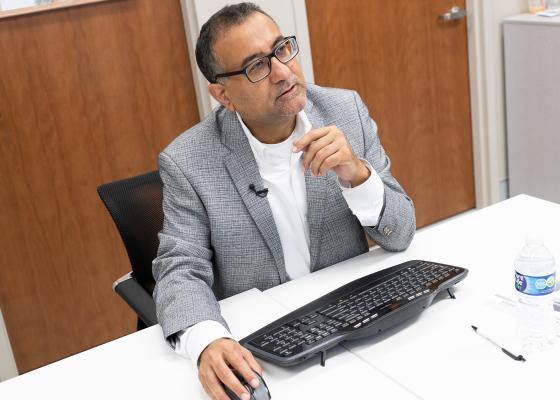
Anil Parwani, MD, PhD, examines a digital image of a cancer biopsy. He leads a program at The Ohio State University Comprehensive Cancer Center—Arthur G. James Cancer Hospital and Richard J. Solove Research Institute that uses artificial intelligence to compare every new case of prostate cancer, identify specific traits and help pathologists make personalized treatment recommendations for each patient.
January 25, 2024 — Digital pathology has both sped up and increased the accuracy of cancer diagnosis over the past 10 years, and now artificial intelligence (AI) could improve these tools even more.
Most people think of AI as someone teaching a computer to recognize and respond (known as “supervised learning”) to perform a specific task automatically; unsupervised learning involves teaching the computer to recognize and respond to certain things but then allowing it to evolve to learn beyond what it was taught.
Though we are nowhere near “unsupervised” AI use in diagnosing cancer, Anil Parwani, MD, PhD, director of the Division of Anatomical Pathology at The Ohio State University Comprehensive Cancer Center – Arthur G. James Cancer Hospital and Richard J. Solove Research Institute (OSUCCC – James), says these tools are becoming a powerful decision-support resource to confirm cancer diagnoses made by trained pathologists. Long-term, they could address a global shortage of pathologists and fill gaps in care.
Parwani says these AI “machine-learning” processes are especially impactful for determining how high or low risk a cancer is, a concept known as “grading” used to determine how likely a cancer is to spread and how quickly.
“There is no routine cancer, so an accurate diagnosis and an understanding of the specific molecular characteristics of each person’s tumor is critically important to match patients to the best treatment options for their specific cancers,” says Parwani. “We already see the positive impacts of this in breast cancer and now in prostate cancer, which are two of the most common forms of cancer.”
Bringing most concerning cases to top of list
Parwani says AI technology also has the potential to pre-screen patients before the pathologist reviews the slides to make a diagnosis so the team can prioritize possible high-risk cancers to speed up confirmation and start treatment sooner.
“From a screening perspective, it is not unusual for me to have 40 cases to review in a day, and many of these are benign. Imagine if we could prescreen all these cases with AI to put the most concerning cases at the top of the stack.”
Computerized screening extends beyond human eye
Pathologists are trained to look at specific features of the cell that are seen through a microscope. Digital pathology took these cellular images – which are traditionally viewed on a series of single flat images on glass slides – and combined them into a single 3D image that can be studied from all angles on a computer. AI can find concerning features outside the cancer cell that are not obvious to the human eye. Parwani explains, these serve as signals to create a risk ranking (low to high) and give important information for guiding treatment decisions.
“So today, we can use AI tools to help us predict these features in patient samples. AI does not make a diagnosis – but once I, as a pathologist, make a diagnosis, I can then use AI to find additional clues that will help the treating oncologist suggest a treatment plan for the patient,” he said. “This is especially helpful in rare cancers or cancers with a specific genetic mutation that might benefit from a very specific therapy.”
The OSUCCC- James is currently testing the use of AI in prostate, breast, gastric and other cancers for diagnosis validation and risk assessment.
Parwani stressed that AI introduction into medicine should be approached with careful intention.
“This is a very powerful technology, and we should be very cautious about how we harness it in medicine to improve care for our patients. It is an incredible diagnostic support and validation tool worthy of continued evaluation,” he said.
For more information: https://cancer.osu.edu/


 January 23, 2025
January 23, 2025 







